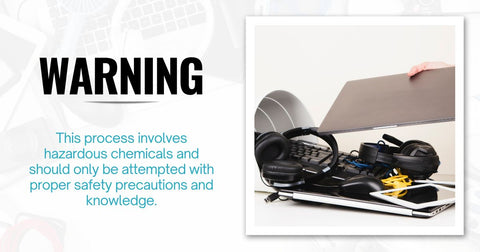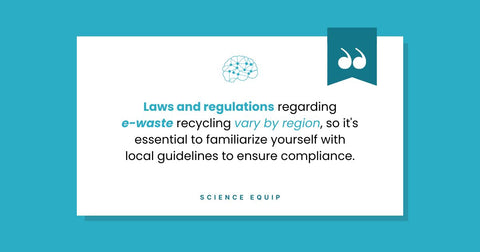In today's fast-paced world, technological advancements have inadvertently led to an increase in electronic waste, or e-waste. This mounting problem not only poses environmental threats but also offers an untapped opportunity for precious metal recovery. Extracting gold and other valuable metals from e-waste not only contributes to environmental sustainability but also offers financial benefits. This blog post aims to guide you through the process of recovering precious metal from e-waste in a straightforward and effective manner.
Understanding E-Waste and Its Potential
E-waste encompasses a wide range of discarded electronic devices, including smartphones, computers, televisions, and more. What many need to realize is that these gadgets are a treasure trove of valuable materials. Precious metal recovery from these devices is not just feasible; it's becoming increasingly necessary as the demand for these metals grows and natural reserves dwindle.
The Importance of Precious Metal Recovery
Recovering precious metals from e-waste serves a dual purpose. Environmentally, it significantly reduces the harmful impact of e-waste on the planet. Economically, it offers an opportunity to reclaim valuable resources. Gold, silver, platinum, and palladium are just some of the precious metals that can be recovered from old electronics. These metals retain their properties indefinitely, making them infinitely recyclable and highly valuable.
Starting with the Basics: Collecting E-Waste
The first step in precious metal recovery is collecting e-waste. Start by gathering old electronics from your home, office, or community. You can also reach out to local businesses or recycling centers to source larger quantities of e-waste. Remember, the more e-waste you collect, the higher your potential for recovering precious metal.
Preparation and Safety Measures
Before diving into the extraction process, it’s crucial to prepare and take appropriate safety measures. Disassembling electronics requires care to avoid damage to the components containing precious metals. Wear gloves, goggles, and a mask to protect yourself from dust and potential chemical exposure. Work in a well-ventilated area to ensure your safety throughout the process.
The Extraction Process: A Step-by-Step Guide
Before we begin, you will need a not-so-few items to ensure your safety and your working environment. Here's a comprehensive list of items that you would need for each step of the precious metal recovery process:
For Disassembling the E-Waste
- Screwdrivers (multiple sizes/types)
- Pliers
- Wire cutters
- Safety gloves
- Laboratory googles
For Manual Sorting
- Sorting trays or bins
- Magnifying glass
- Tweezers
- Protective gloves
For Chemical Stripping
- Beakers or Flasks
- Hydrochloric acid
- pH indicator strips
- Nitric acid
- Safety goggles
- Fume hood or well-ventilated area
For Metal Precipitation
- Chemicals for precipitation (Sodium Metabisulfite, Urea, etc.)
- Precipitation tanks or containers
- Chemical resistant gloves
- Safety goggles
For Purification and Refining
- Refining chemicals (dependent on the method)
- Heat source
- Crucibles
- Protective high-temperature gloves
- Electrolysis setup (if using electrolysis)
General Safety Equipment
- First aid kit
- Fire extinguisher (chemical-specific)
- Apron or lab coat
- Dust mask or respirator
- Storage containers for both raw and refined materials
- Labels and markers for clear identification of materials and chemicals
Additional items might be necessary depending on the specific materials being processed and the scale of the operation.

WARNING: This process involves hazardous chemicals and should only be attempted with proper safety precautions and knowledge. Now, let’s move on to the extraction process:
1. Disassemble the E-Waste
Begin the recycling process by disassembling electronic devices with the right tools. They focus on extracting circuit boards, connectors, and components like transistors, capacitors, and resistors, which often contain gold or other precious metals.
2. Sort the Components Manually
After disassembly, the next step involves sorting the components by material type. This is done by separating components with visible gold plating or other metallic coatings suspected of containing precious metals for further processing.
3. Prepare the Chemical Solution
In a well-ventilated area, carefully mix the required chemicals in a glass container, adhering to safety protocols. Lastly, heat the mixture to expedite the metal dissolving process.
4. Submerge and Monitor the Components
Submerge the components in the solution that are suspected of containing precious metals. Then, closely monitor this process to prevent overexposure as this could also dissolve the base metals.
5. Neutralize the Acid Solution
After dissolving the metals, neutralize the remaining acid solution with a sodium carbonate solution (washing soda). Make sure it's safe to handle and dispose of.
6. Precipitate the Metals
Add a specific chemical solution to the neutralized solution. This will cause the dissolved metals to precipitate out of the liquid, forming a solid metal compound. Moreover, it’s important to be patient. Allow the solution to sit undisturbed so the precipitate can settle completely.
7. Filter and Collect the Precipitate
Then, the solution undergoes careful filtration to collect the precipitated metal compound. Thoroughly rinse the collected material with clean water to remove any residual chemicals.
8. Purify and Refine the Metals (Optional)
The recovered metal precipitate may undergo further processing to achieve higher purity. Moreover, electrolysis or other specialized methods require additional equipment and expertise. So for obtaining high-purity precious metals, consulting a professional refiner is advisable.
Important Note:
- Recovering precious metals from e-waste can be complex and hazardous. This guide is for informational purposes only and should not be a substitute for proper training and safety precautions.
- For small-scale operations, responsible recycling of e-waste through certified electronics recyclers might be a safer and more environmentally friendly option.
Turning Waste into Wealth
The process of precious metal recovery from e-waste is not only environmentally beneficial but can also be financially rewarding. The value of recovered gold and other precious metals can add up, offering a lucrative side business or hobby. Additionally, by recovering precious metals, you reduce the demand for newly mined metals, benefiting the environment.
Challenges and Considerations
While the potential for precious metal recovery from e-waste is immense, it's important to acknowledge the challenges. The process requires careful handling of toxic chemicals and a basic understanding of chemistry. Additionally, laws and regulations regarding e-waste recycling vary by region. So it's essential to familiarize yourself with local guidelines to ensure compliance.

Conclusion
Precious metal recovery from e-waste represents a remarkable opportunity to turn electronic waste into valuable resources. By following the steps outlined above, you can contribute to a more sustainable future while potentially reaping financial benefits. The key is to approach the process with care, respect for safety guidelines, and a commitment to learning and adapting. As technology continues to evolve. So too will the methods for precious metal recovery, promising even greater rewards for those willing to explore this fascinating endeavor.
